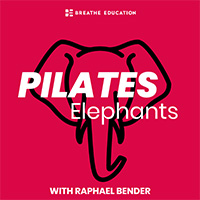Episode 27
27. Headrest Up Or Down?
We were all taught “headrest down when your hips are higher than your head” and most of us have followed this rule without thinking.
But is it actually dangerous to leave your headrest up during shoulder bridge, or short spine?
When you think about it, in rollover on the mat, your neck is much more flexed than in shoulder bridge on the reformer, even with the headrest up.
We have a double standard about loading joints at end range – in the hips it’s good (e.g., lunges, front splits & side splits), but in the neck it’s bad.
What about activities where people regularly bear their body weight on a fully flexed neck, like yogis doing halasana and karnapidasana, and breakdancers and wrestlers, not to mention Sherpas?
Resources mentioned in the episode:
- Episode 13. Cueing Elephants
- Injury risk is multifactorial here and is related to sleep duration here
- Resilience and self-efficacy are negatively correlated with neck disability here
- Basically no difference on MRI between people with and without neck pain here
- Neck posture is unrelated to developing either disc bulge or symptoms over 20 years here
- Adding neck stabilisation exercises to general neck strengthening does not improve outcomes for people with neck pain here
- Cervical disc degeneration is 74% heritable here
- Most injuries in fitness facilities are from people dropping weights on themselves, or tripping over here and here
- Pig neck spinal bones are injured by compressive load, not by flexion here and here
- And human lumbar spinal segments are actually BETTER at resisting compression when they are in a flexed position here
- Crossfit participants have no more injuries than participants in any other exercise modality here
- Yoga is safe AF and people don’t injure their necks doing halasana here and in particular Ashtanga yoga here
- So is spinning on your head when breakdancing here and here and here
- Wrestlers have very few training-related neck injuries here
- Risk factors for neck pain include having more children, being 45-54 years old, being out of work, smoking, a history of LBP, poor psychological health, and… it’s 48% heritable here
- If left untreated, 84% of people with symptomatic cervical disc bulge and nerve-related arm pain recover completely within 24-36 months here
Connect with me on Instagram: @the_raphaelbender
Download a free course guide:
Become a Breathe Education Mentor Affiliate: Program info
This podcast uses the following third-party services for analysis:
AdBarker - https://adbarker.com/privacy


